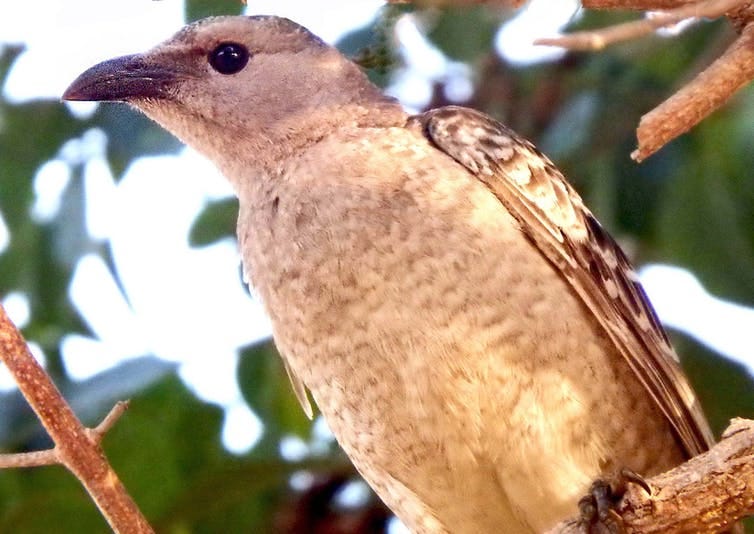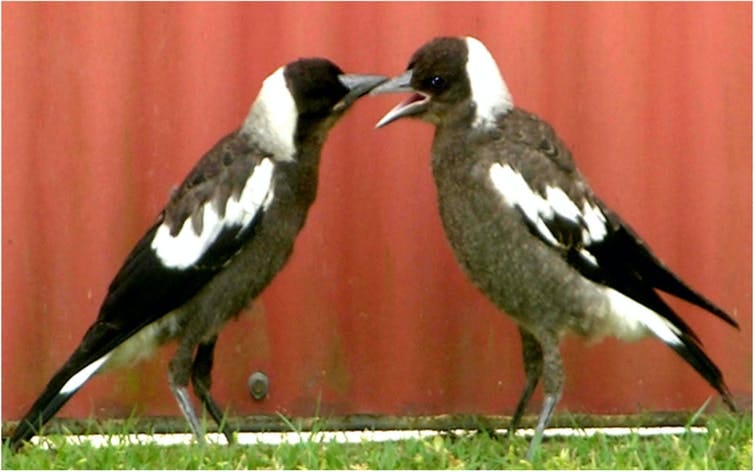Bird-brained and Brilliant
By Gisela Kaplan, University of New England
Calling someone a “bird brain” is not usually meant as a compliment. But as research continues to reveal, birds are much smarter than was once thought.
Australian birds are arguably among the smartest in the world. Some display complex behaviours such as problem solving, learning and tool use comparable to behaviours observed in great apes.
I’ve summarised what we know about Australia’s exceptional birds in my book Bird Minds, showing how versatile and complex our native birds really are.
The smarts of singing
It all starts with the brain. We once believed that small brains equal little thinking, but we now know that this is not true. Just as the smallest computer chips can fit an enormous amount of memory, bird brains can too. This is precisely what was discovered in songbirds by first studying the song control system in the native Australian Zebra Finch.
Research showed that their tiny brains have a complex network of neurons dedicated to learning song and storing it in memory. And such learning is aided by mirror neurons (brain cells), as in humans, capable of committing heard sounds to memory. These special neurons are active in the listening bird as if it were singing itself.
When the bird sings that song again it can then be checked against the stored memory. This is a brilliant biological solution to achieve learning, as has also been found in humans.
Many Australian birds are brilliant mimics. Mimicry was once dismissed as “mindless”. In fact, it’s the first stage of learning.
Human babies and infants do it all the time, gradually linking the mimicked sounds with words and meaning. Eventually they are able to apply specific sounds in a correct context. That is not mindless.
For instance, my galah learned to call the dogs by their names and would wait until they came running to him!
A magpie used dog calling in another way. A cat wanted the magpie gone, then the magpie called the dog’s name. The dog came running and chased the cat away. The magpie stayed.
Many Australian species mimic in the wild. Lyrebirds and magpies have the most varied forms of mimicry, followed by parrots and parakeets, Satin Bowerbirds, Spangled Drongos and many others.

Food for thought
It is perhaps the fickleness of this continent’s climate that demands insight, problem solving, remembering the location of food sources and other cognitive qualities in order to survive. Securing food is a major problem in a continent that has regular fires, droughts, heatwaves and storms. Known food sources can suddenly disappear and may not return for some time or remain patchy.
The abilities to travel long distances and learn to utilise different food sources when staple diets are not available provide obvious advantages. One of the remarkable adaptations of many Australian birds is the ability to switch foods. Insect eaters such as Rufous Whistlers and large birds like ravens, magpies and currawongs have even been seen harvesting nectar.
Confirmed hunters of birds and insects such as butcherbirds, Torresian crows, currawongs and shrike tits have learned to avoid the toxicity of their prey, be this caterpillars or cane toads.
So far 18 species of Australian native birds have been identified as tool users, often in relation to getting food. Noisy Pittas and White-Winged Choughs know how to use implements to open hard-shelled gastropods. Black-Breasted Buzzards place a rock in their beak and use it as a hammer to crack open emu eggs. Black Kites may pick up glowing sticks in and around bushfires to start a fire elsewhere and gain access to more food.
Palm Cockatoos are among the few species worldwide that use and manufacture tools, while bowerbirds stand out as architects and painters.
Old, and wise
All modern songbirds and a number of other lineages (such as ducks, chickens, pigeons, parrots and cockatoos) evolved in East Gondwana, now Australia.

Cockatoos evolved around 90 million years ago and have very large brains in relation to body size; the largest in the Palm Cockatoo. Among parrots, the Budgerigar and the Musk Lorikeet have particularly large brains compared to body size.

The Satin Bowerbird and Great Bowerbird have above-average brain-body ratios. So do some honeyeaters, Noisy Miners and possibly the corvids, known worldwide for showing behaviour that requires problem solving.
Australian birds tend to be long-lived, have long breeding seasons and share parental or group care of offspring, often for extended periods. Indeed, Australia is a hotspot for co-operative species. These conditions provide time for youngsters to learn and play while still protected. Moreover, time is one of the prerequisites for growing a large brain.

Magpies may belong to the few species worldwide that can play a meaningful game of hide and seek, comparable to the performance of 3-5-year-old children. Birds can express complex emotions, even showing empathy and grief.
The lives of native birds are complex and depend on more than instinct to survive. This includes a superb long-term memory, minds capable of complex behaviour, extensive communication and good decision-making.
Australian birds are beautiful and odd, resourceful and innovative. Not just pretty things, they are also curious, emotional, smart and adaptable.
Gisela Kaplan, Professor of Animal Behaviour, University of New England
This article is republished from The Conversation under a Creative Commons license. Read the original article.
TODAY'S FEATURED BOOKS









